#i was too lazy to draw buildings for the perspective project in art 1 so I made this instead
Text
High Lord Wolnir my beloved
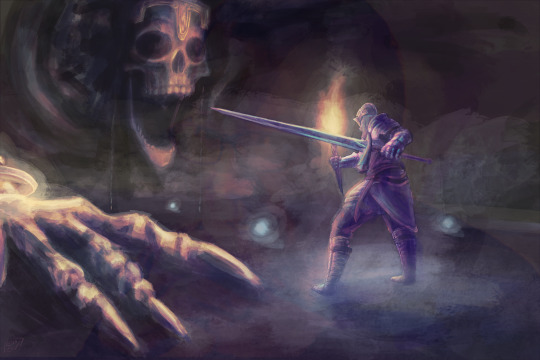
#digital art#dark souls#dark souls 3#high lord wolnir#high Lord wolnir my beloved I love this silly little guy so much :)#fromsoft fanart#fromsoftware#ds3#dark souls fanart#i was too lazy to draw buildings for the perspective project in art 1 so I made this instead#skajillies
238 notes
·
View notes
Note
How did you learn to draw? How do you find time for all of your projects? WILL YOU TEACH ME THE SECRETS OF YOUR PRODUCTIVITY? :D
My art journey (beyond the usual childhood doodling) started with fanart of Aang from ATLA as a goth when I was in...middle school? Maybe late elementary school. IDK. Still have it the drawing, though. Somewhere. It’s buried in a box right now, otherwise I’d share a picture of it. Can’t remember why I felt the need to draw Aang as a goth, but I sure did it. Also, his head was about 1/3 of his height.
Anyways.
That was basically where I started, and how I learned a lot of my skills: I saw cool things, so I drew them. Sometimes this was cartoons/anime I liked, sometimes it was weird trees, sometimes it was cool buildings (there’s one particular building in Japan that I drew for half a dozen school assignments over the years), etc. As I got older I got more serious with my learning by doing things like gesture drawing, life drawing, studying other artists I love, that sort of thing. I am a firm believer in the power of references and learning from real life, even if you want to do more stylized work.
As for finding time. Well. Who the fuck knows. I have a terrible concept of time (thank you ADHD) so how I find it is beyond me. I have never felt overly productive--not lazy, just not super productive either, but I have ALWAYS been told I am in fact super productive? IDK. Time is weird. Other people’s standards are weird.
With that said, a big reason I can put out the things I do and at the pace I do is that I’m drawing what I enjoy. Right now that’s mostly pretty ladies in pretty clothes, very detailed things, and a handful of characters I adore. I don’t draw those things for validation, though the validation of people liking them is still super delightful, I just draw them because they’re fun! I love putting together unique outfits and new faces and playing with perspective and layering colors and messing with lighting across complex scenes.
I also have things going at all stages of completion. So, like, if I don’t feel like inking one day I can go color another piece. But if I get tired of coloring I can go ink something. Or go sketch something. Or go paint something. This really helps me keep going when ADHD decides a task is Wrong because I can just switch to a different task that is still art and still getting something done. It is a good brain trick. Works for writing too. I can switch between writing, content editing, line editing, plotting, researching, etc. until I find the proper task for my brain at that point in time.
For example, here is my To Do art folder:
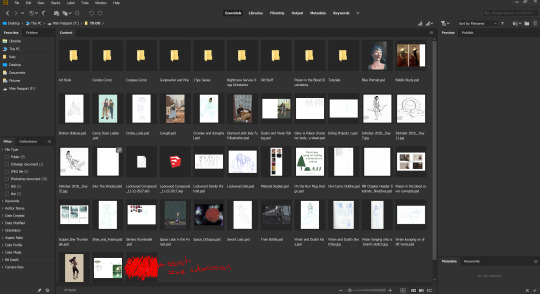
Got a little bit of everything in there! Some bigger projects in folders, some studies, some paintings, some 3D models, some new characters, some concept/layout art. Lots of stuff to keep my brain happy no matter what mood it is in. Not all of these will turn into finished projects, and some have been in here for ages, but I like having them!
Aaaaaaaaaannnnnd, yeah! Hope people can find something helpful in this ramble. If anyone has any other art/writing based questions tonight or any time in the future please don’t hesitate to ask! Always happy to ramble about art.
Anonymously message me (3) things you want to know about me.
54 notes
·
View notes
Text
5 Common Writing Problems and Their Solutions (That I Never Use)
If you’re a writer and you’re anything like me, you know exactly what you struggle with--and maybe you even know how to fix it--but you just keep trudging along doing the same thing you always do. Why? Maybe writers just like the torture.
But maybe it’s time to make life easier on ourselves. Here are the top 5 “writer problems” I always have and am too lazy to fix. (Be better than me.)
1. Forgetting a character’s last name/eye color/scar description, the town’s name, their mother’s name, what they were wearing in the scene, etc. and then having to scramble back and re-read nearly the whole book to find one tiny description.
Solution: Take notes while you write. A great way to start would be to make a document (spreadsheet would be perfect) listing each major and minor character and jot down the basics: full name, relations to the other characters, style, physicality, etc. This way you can refer back to the little things in one simple quick place instead of fumbling through 200+ pages as you write.
2. Writing the same story for so long you forget why you were writing it to begin with, what the point was, and if it’s even worth it.
Solution: I think this is particularly true for novelists; when you embark on something that long, you’re bound to get lost and begin to wonder if you should even finish. And while the answer isn’t always yes--some books just weren’t meant for you to write them, but maybe the next one will be the one--it’s worth going back to the drawing board. The more notes you make before you start writing, the better. Jot down the big plot points, jot down the “mood” of the book you hope to convey, write down the audience you want to reach, the message you want to get across, anything and everything that you want this book to be when it’s finished. Make playlists, create art, do anything and everything you can to capture your excitement when you first get an idea. Referring back to this later--when you’re treking through the mud that is the actual writing--can help to find that spark again and give you your second wind.
3. Looking for the right word, phrase, or fact, but being unable to find it and so you stop writing and obsess over it instead for hours.
Solution: Put a bracket such as [physical description; placeholder] and move on. The first part is a note for yourself--whether it be ‘eye description, town name, personalty type’ etc. Whatever it is that you wanted to write but don’t have the write words for later, jot down a quick note of what it should be in the end, that way when you come back to it, you’ll know the basics of what you wanted. The second part, 'placeholder’ or whatever other word you might choice (but keep it consistent), is so that you can put it into the finder option on your document and easily go back to it later without searching.
You won’t always have the answers, and sometimes writing isn’t just putting words on paper--it’s research, consistency, planning. But don’t let the things you don’t know keep you from writing, especially if you’re on a role or feeling inspired. Getting too caught up on one word can put you in a rut and kill the muse. And chances are, you’ll figure it out later when the pressure isn’t on and you’ve had more time to think about it.
4. Editing while you’re writing and rereading each sentence so much that you forget/lose the energy to write any more and decide it will never be good enough. Alternatively; it takes you several hours to write one page.
Solution: Edit later. Let the words come as they may, put them on paper, let them live there for a while. You can always go back and change anything. Writing it down doesn’t set it in stone, but it does allow you to get it out of your head and into the real world where it’s easy to evaluate, adjust, and bring to life. Drafts exist for a reason; let your first draft be crappy, and then un-crappify it once you’ve gotten all the fresh ideas onto the page. You may find that you right some of your best sentences and get your best ideas when you let the editor go, when you don’t worry about it sounding right or about perfection. Allowing yourself the room for bad writing often produces even better writing because it removes the limitations on your creativity.
5. Considering abandoning the whole project because you’re worried the character isn’t unique enough, is too like another well known character, or you just can’t pinpoint their voice.
Solution: Write a character biography before you ever begin writing. Even better, write a character interview. Ask them weird questions and answer in two ways: what they would say to an interviewer and what they would only think to themselves. This allows you to figure out not only their thoughts and feelings (which will be especially important in first person narration) but how they present themselves to the world. Honing in on those unsaid things helps you to develop motivation and to begin to plant hidden meaning and clues to their inner psyche without revealing it all via dialogue (making for a far more interesting read).
Knowing your character’s home life, location, and relationships will help you to figure out how they react to their world and how their circumstances have built their character. But the nuances are what make them unique. Decide what they would buy at the grocery store five minutes before closing. What was the first book they ever read and do they peek at the last line first to see how books end? Do they steal food off of other people’s plates? Go beyond the basic biography and get specific. A quick search for ‘character development questions’ can give you hundreds of really helpful places to start.
In short: no one’s basic biography is going to be unique. With millions of stories out there over hundreds of years, there are only so many variations of the life story: people have parents or they don’t, they have money or they don’t. Even the most unique perspectives may have been “done before” but that doesn’t mean you can’t do them again if you take the time to build them into real three dimensional people with unique opinions. Don’t rely just on their backstory or position in life to make them interesting; dig deep and make them a real person, and I promise, that will be enough.
ANCwritingresources is open to submissions, questions, and recommendations. Check out my new book, Permanent Jet Lag, out now!
Book Purchase Links
NineStar Press, Amazon, Smashwords, Barnes & Noble, Kobo
882 notes
·
View notes
Text
Anonymous asks:
(hope you don’t mind me asking this) what’s your art process like? can you share what materials you use?
Sure.
My process varies depending on how much I give a crap about the things I draw. Usually it starts off with an idea. Then it starts off with me trying to commit that idea to paper. Then I usually scream at this point as I try and find the motivation I need to grab a pencil and actually do this idea. This, incidentally, is probably the hardest stage in the process. Once I start drawing, it’s usually smooth sailings from here on; any mistakes I make tends to come up after I finish the work, and then I scream some more and wonder what I did wrong with my life.
I’m a traditional artist because my computer doodling skills is about as amazing as a lethargic boomerang that gets tossed and never comes back. I mostly use mechanical pencils, various ink pens (I’ve recently gotten into copic multiliners, though I have luck with Faber-Castells and micron ink pens) to ink my work. Copic markers (usually sketch sized) are my primary coloring choices; they often a wide variety of colors and is refillable to boot. I have some prismamarkers as well, but I don’t use them much nowadays. Still, I have a bushel of them as back-up just incase.
Here’s my current set of supplies, give or take. The Transformers Animated lunch box houses most of my prismamarkers. It’s hard to see, but the refillables are to the far right of the photo. These things cost a bazillion dollars despite me being poor. Maybe I should get one of them Patreon thingamabobs.
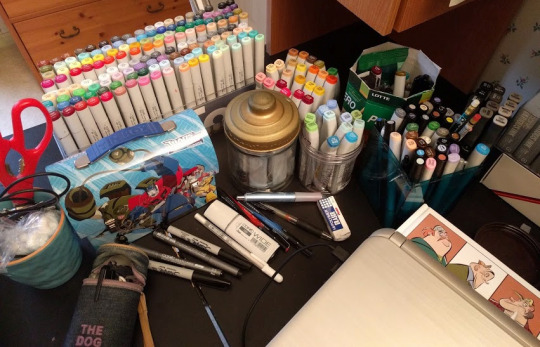
These are my current sets of pencils, ink pens, and other doo-dads I use to draw before I color the dang thing. I don’t use sharpies whenever I draw artwork I give two shits about because they bleed through easily. Those tools are often reserved for my black and white scribble comics where I don’t care as much to make it look good.
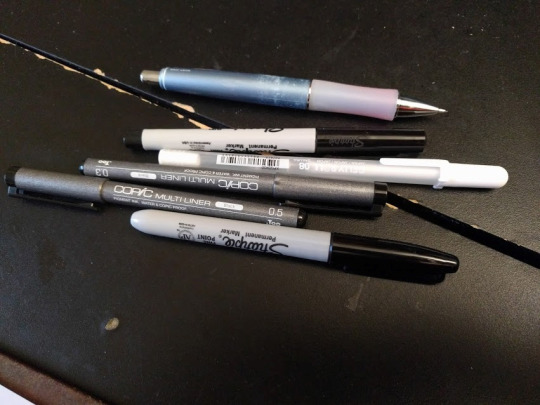
How I draw depends on whether I’m giving a damn or not.
When I draw half-assed comics and art, I tend to make up shit on the spot. Here’s an example from this Shovel Knight prospecter comic I’m currently drawing (I took this pictures with a phone because I’m too tired and lazy to use a scanner. Sorry.)
I start off with a rough sketch as seen here on these sets of pages. Usually I work one page at a time, but sometimes I draw them all in advance like I did here, mostly to try and motivate myself to finish the damn thing.

Then I would ink over it (mostly I use a sharpie just to preserve my better art supplies for bigger projects) as seen here.
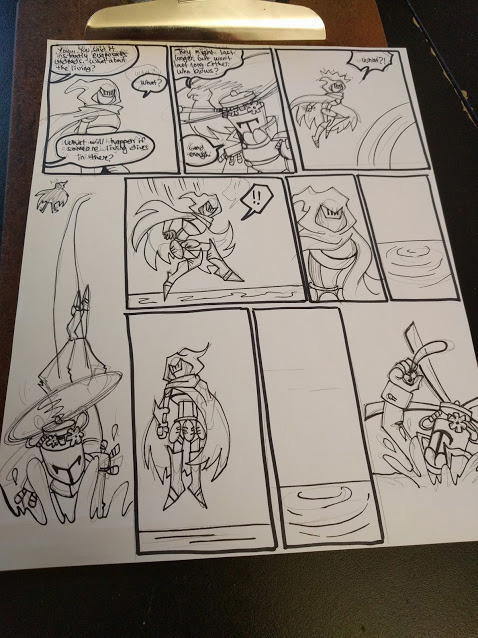
Here’s a finished version ready to be posted in the near future once I touch up minor edits on photoshop and fill up the world balloons with typed text. Incidentally, I don’t usually draw the word balloons in comics so I have a greater control of editing in speech bubbles via photoshop on the final product, but that only ever applies to my webcomic; simple ones like these I do just draw ‘em in because it makes the process faster. Basically I take more shortcuts depending on the ratio of how much effort I’m willing to put in a work.

Artwork I DO give a damn is slightly different. Most of the time, this is going to be my webcomic, Prince Marine: The Dandy Robot (*cough* link HERE if you’re interested in giving it a whirl. *cough*) That one is like planning out a friggin' symphony. I conceptualize a general story idea, figure out how it fits in the continuity, then jot down a script. As of this post, I have up to Chaper 8 ready to be drawn in the future (to put it into perspective, Chapter 4 is the current story that’s publically up on my site.) I then usually draw a thumbnail/rough sketch on how I want it to look.
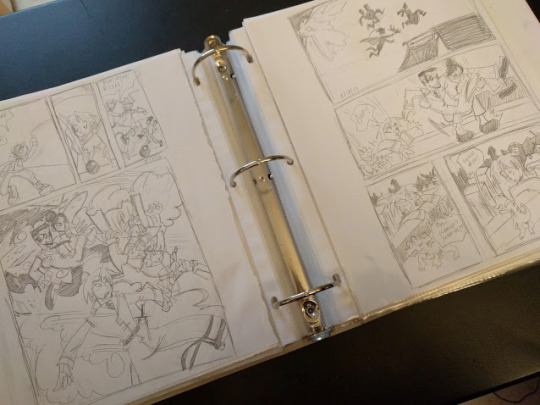
These are the dummy pages, the ones I use as guidelines for the final product. The first 200 or so pages were actually drawn when I had only a rough guideline for the first five or so chapters; everything from dialogue to how word balloons were placed were improvised on the spot before I wrote my first full script. I’ve changed a lot of elements from the original editions since, but they served as building blocks for the first five chapters. The image above for example isn’t much different from the finished pages below:
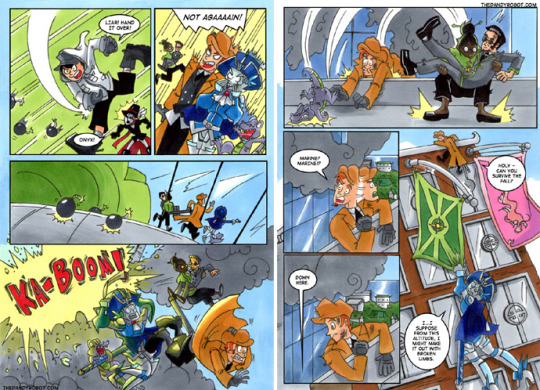
The same rule applies to colored products. Ones that are simple and largely stress-free work are drawn on the spot once I think of an idea. Bigger ones are planned much like my comic, such as my recent Hyper Light Drifter 1-year anniversary pic.
Rough draft on my sketchbook to get an idea:

A work-in-progress on a new sheet of paper:
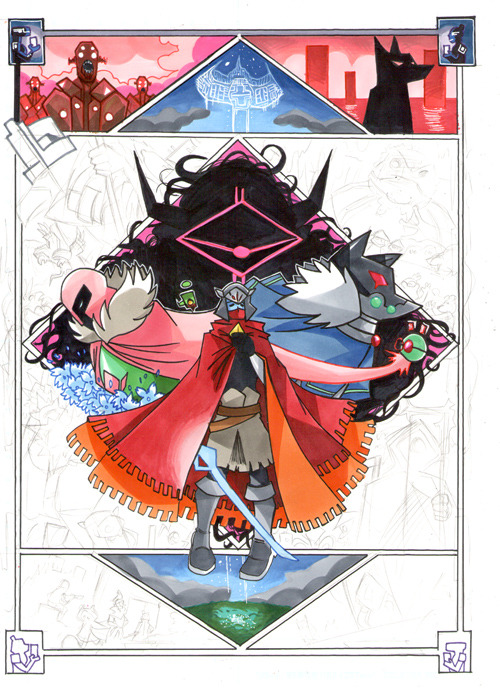
Finished result with any minor little things I need to fix and add done in photoshop.

I use a variety of paper depending on how much I give a shit. Printer paper is my default for garbage doodles as well as concept arts and practices. Printer paper, FYI, are often not quality paper for the tools that I use, but they do in a pinch if I want to draw something super quick and cheap on the fly. That goes double for sketchbooks. It’s hard to find a good one that can support markers very well, but I usually go for ones where the pages don’t feel too rough nor too smooth. Rough and the markers look kind of spotty. Sometimes I think it leaves a neat effect like this art, but I don’t often recommended it if you’re aiming for quality. Too smooth and the colors don’t feel as vibrant.

I think so far, the “just-right” papers I’ve found are the Deleter Comic Book Pages and Hammermill printer paper; the latter of which has a stock card-like feel that makes it perfect for markers. That would be the two papers on the left side of the above picture.
That’s basically about it. I hope that gives you a somewhat decent idea of how I do things. Thanks for asking!
#neoyi#neoyi arts#neoyi talks#hyper light drifter#the dandy robot#prince marine#shovel knight#prospecter#comics
33 notes
·
View notes